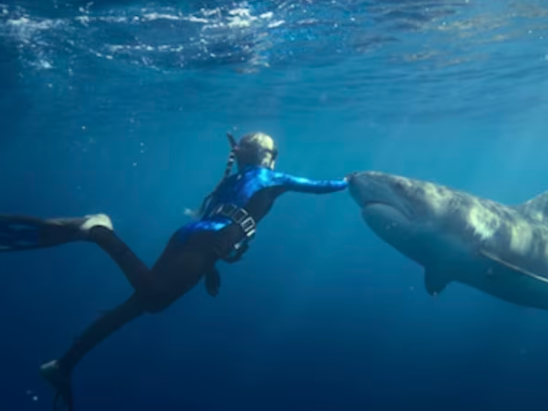You’ve probably already seen one of her viral videos: a woman free-diving, gently brushing against a tiger shark or holding onto the dorsal fin of a great white. That woman is Ocean Ramsey, a Hawaiian marine biologist and a polarizing figure in the animal protection world. Netflix is now dedicating a 90-minute documentary to her, “At Peace with Sharks” (“Shark Whisperer”). Directed by James Reed (“My Octopus Teacher”), J.P. Stiles, and Harrison Macks, the film dives into her daily life — balancing activism and media strategy. Behind the spectacular footage lies a deeper exploration of the ethical boundary between influence and conservation, and it sheds light on the tensions surrounding shark advocacy.
An Immersion into Marine Life
Ocean Ramsey, a marine biologist and freediver from O’ahu, Hawaii, is renowned for her close interactions with sharks — especially great whites and tiger sharks. Her mission: to change the public’s negative perception of these misunderstood predators. The documentary follows her during cage-free dives, where she swims alongside the animals to prove they are not the bloodthirsty man-eaters they’re often portrayed to be.
Much of this breathtaking footage, often filmed by her husband Juan Oliphant, is the result of decades of work and deep passion for the ocean and its inhabitants. Over thousands of dives, the 38-year-old scientist has identified and cataloged hundreds of individual sharks — a massive contribution to marine science.
Fighting for Shark Protection
After years of tireless campaigning, Ramsey was instrumental in the passage of a groundbreaking law in Hawaii that bans the killing of sharks — the first legislation of its kind in a U.S. state. As she often reminds audiences, nearly 100 million sharks are killed each year, mostly for their fins, while shark attacks on humans remain extremely rare.
She also co-founded One Ocean Diving, a Hawaii-based company offering educational diving experiences with marine wildlife to raise awareness and promote shark conservation.
A Controversial Approach
With over 2.2 million Instagram followers, Ocean Ramsey uses social media to amplify her message. Her posts often show her swimming dangerously close to some of the ocean’s most feared species, touching them, and even riding their dorsal fins. She defends this bold approach, arguing that the attention and emotional reaction sparked by such images are powerful tools for conservation.
But not everyone agrees. Some scientists featured in the documentary criticize her methods, saying they may be unsafe — both for her and the animals — and could inspire copycat behavior among less experienced divers.
What Shark Behavior Really Reveals
Thanks to her countless dives, Ocean Ramsey says she has learned to read the body language of sharks, which she describes as a kind of dance, much like bees: swimming side-by-side, bumping one another to assess dominance, or smaller individuals tucking underneath larger ones. Just as Jane Goodall did with chimpanzees, Ramsey has named the sharks she regularly encounters, noting their individual personalities and claiming to form real bonds with them.
She also explains how certain behavioral cues can signal potential aggression, and how she adjusts her own body language — through posture, angle, stillness, or controlled contact — to calm the animal or communicate clearly in return.
Deep Blue and Roxy: Shark Celebrities of the Documentary
Among the many sharks featured in the film, two stand out. First is Deep Blue, a legendary female great white estimated to be over 20 feet (6.1 meters) long and weighing more than two tons. First identified near Mexico’s Guadalupe Island, Deep Blue made a surprise appearance in Hawaiian waters as Ocean and her husband were filming tiger sharks feeding on a sperm whale carcass.
One of the film’s most powerful scenes shows this massive apex predator gliding through the water for over 30 minutes without displaying any aggressive behavior — even allowing the young woman to hold onto its dorsal fin. “If she saw us as prey, she would have attacked already,” Ramsey comments. These sequences, a far cry from Jaws-style horror depictions, went viral around the world and helped restore the species’ reputation. Ocean Ramsey even claims that they had a decisive impact on public opinion. Just days later, in 2019, a law banning the killing of sharks was finally passed in Hawaii — after years of resistance.
The other shark star of the film is a female tiger shark named Roxy. Easily recognizable, she bears a misshapen jaw caused by a fracture from a fishing hook — a stark symbol of the damage inflicted by the fishing industry. But her injury is more than cosmetic; it nearly cost her her life by impairing her ability to feed and defend herself. Against all odds, and despite numerous challenges, Roxy managed to adapt — and survive.
Source: geo



